8. Counta()
COUNTA determines whether a cell is empty or not. You’ll come across incomplete data sets daily as a data analyst. Without needing to restructure the data, COUNTA will allow you to examine any gaps in the dataset.
SYNTAX = COUNTA (value1, [value2], …)
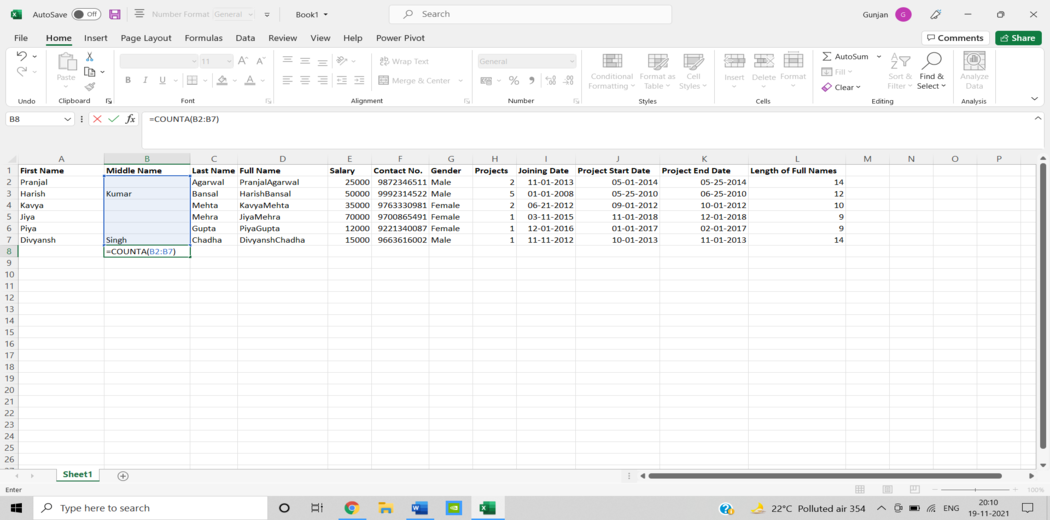
9.Vlookup()
The acronym VLOOKUP stands for ‘Vertical Lookup.’ It’s a function that tells Excel to look for a specific value in a column (the
so-called ‘table array’) to return a value from another column in the same row.
SYNTAX = VLOOKUP (lookup_value, table_array, column_index_num, [range_lookup])
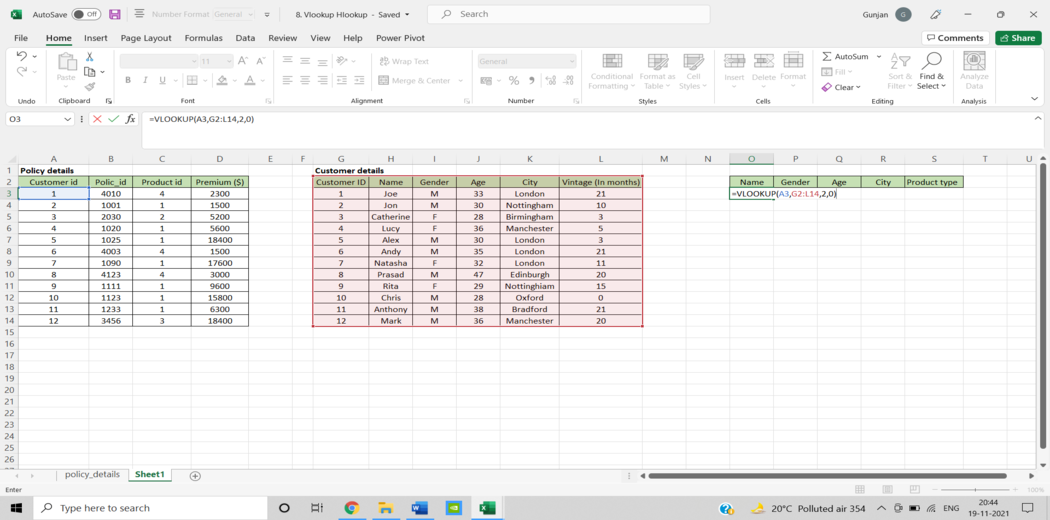
10. Hlookup()
“Horizontal” is represented by the letter H in HLOOKUP. It looks for a value in the top row of a table or an array of values, then returns a value from a row you specify in the table or array in the same column. When your comparison values are in a row across the top of a data table and you wish to look down a specific number of rows, use HLOOKUP. When your comparison values are in a column to the left of the data you wish to find, use VLOOKUP.
SYNTAX = HLOOKUP (lookup_value, table_array, row_index, [range_lookup])

11. If()
The IF function comes in handy a lot. We can use this function to automate decision-making in our spreadsheets. We could use IF to make Excel conduct a different computation or show a different value based on the results of a logical test (a decision). The IF function will ask you to run a logical test, as well as what action to take if the test is true and what action to take if the test is false.
SYNTAX = IF (logical_test, [value_if_true], [value_if_false])

12. Iferror()
We could display a more informative error than Excel does, or even execute an alternative computation, by using IFERROR. Two things are required for the IFERROR function to work. What value should be checked for an error and what action should be taken instead.
SYNTAX = IFERROR (value, value_if_error)
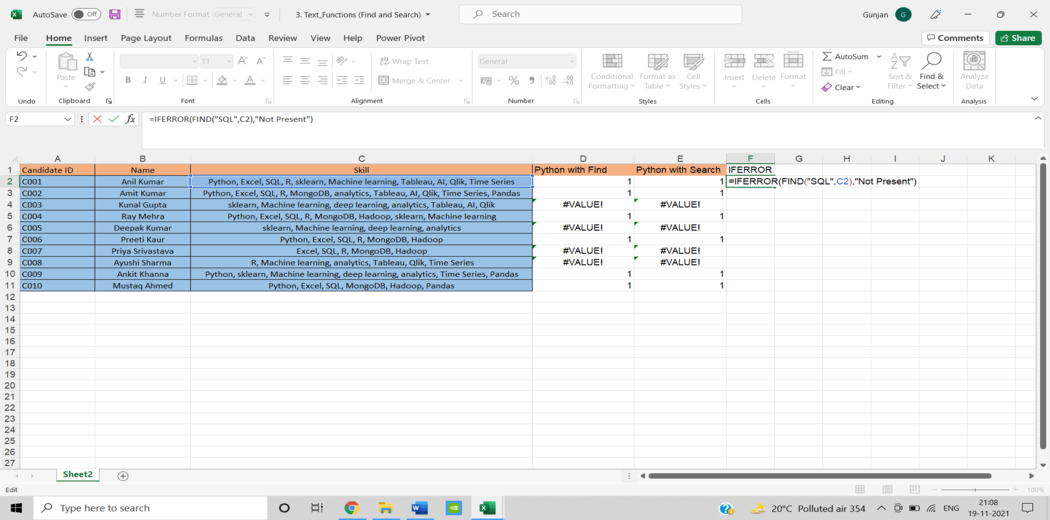
13. Find/Search
The FIND function in Excel returns the position of one text string within another (as a number). FIND delivers a #VALUE error if the text cannot be located.
However, a =SEARCH for “Bigger” will return results for Bigger or bigger, broadening the scope of the query. This is very helpful when searching for anomalies or unique identifiers.
SYNTAX = FIND (find_text, within_text, [start_num])
SYNTAX = SEARCH (find_text, within_text, [start_num])
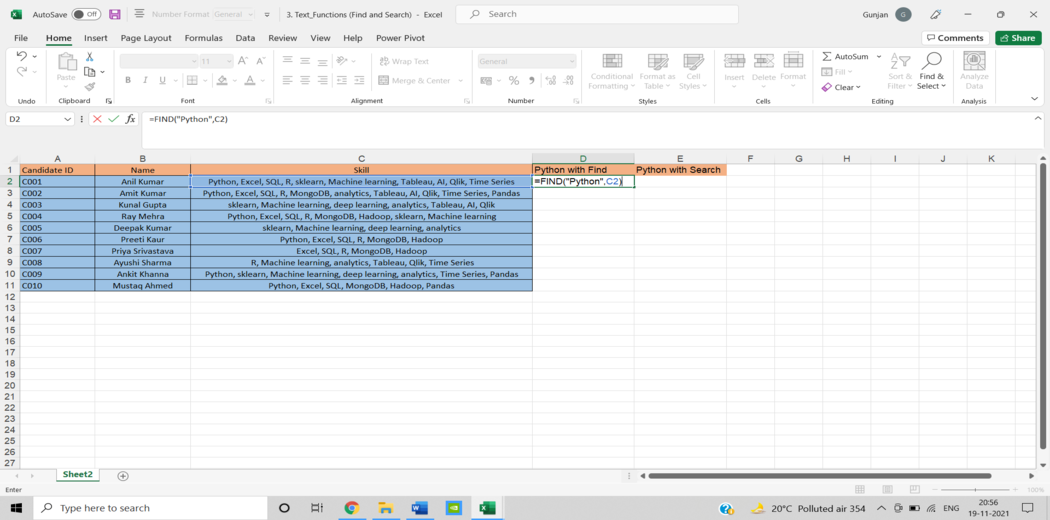
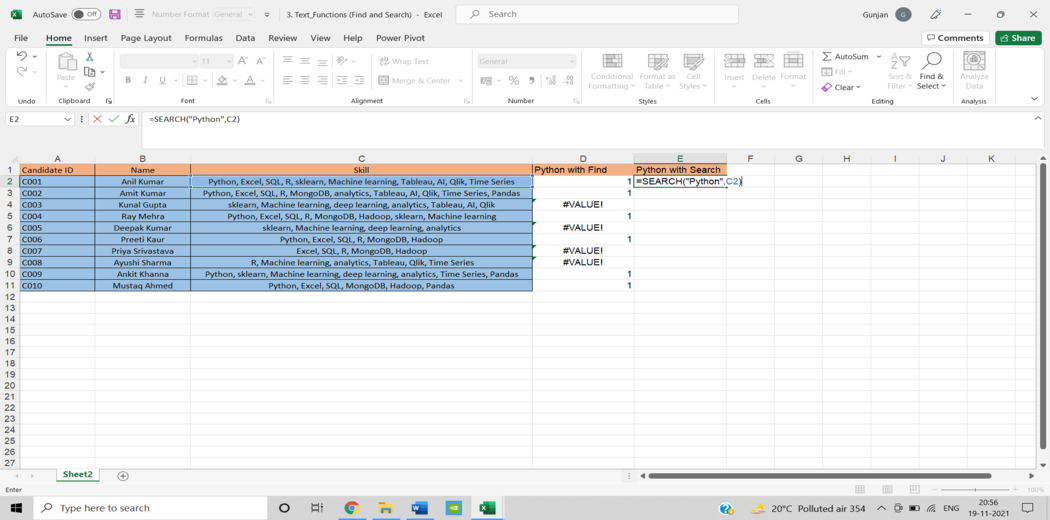
14. Left/Right
=LEFT and =RIGHT are simple and efficient ways for retrieving static data from cells. =RIGHT returns the “x” number of characters from the cell’s end, while =LEFT returns the “x” number of characters from the cell’s beginning. In the sample below, the consumer’s area code is extracted from their phone number using =LEFT, while the last four digits are extracted using =RIGHT.
SYNTAX = LEFT (text, [num_chars])
SYNTAX = RIGHT (text, [num_chars])

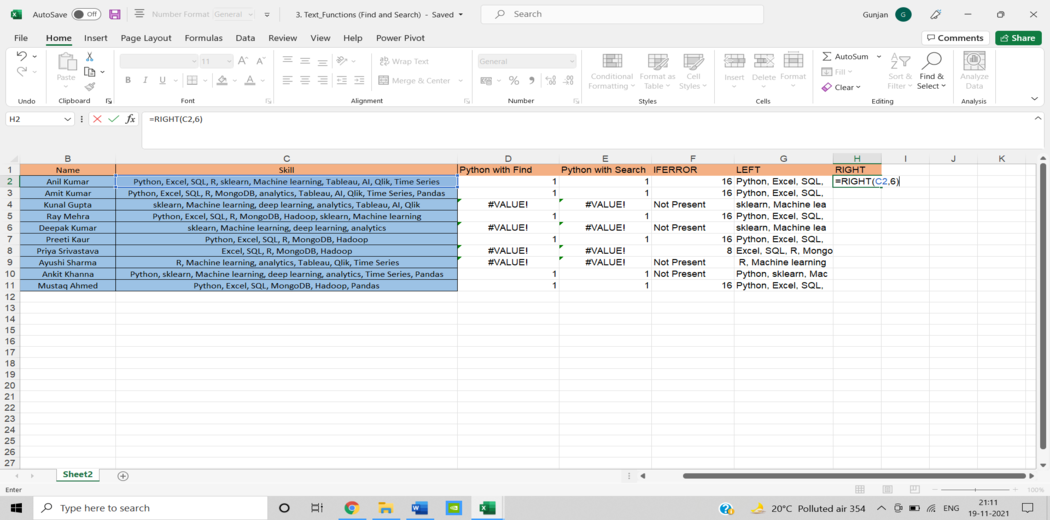
15. Rank()
Even though =RANK is an old Excel function, it is nevertheless useful for data analysis. =RANK is a quick way to show how values in a dataset rank in ascending or descending order. RANK is being utilised in this case to determine which clients order the most stuff.
SYNTAX = RANK (number, ref, [order])
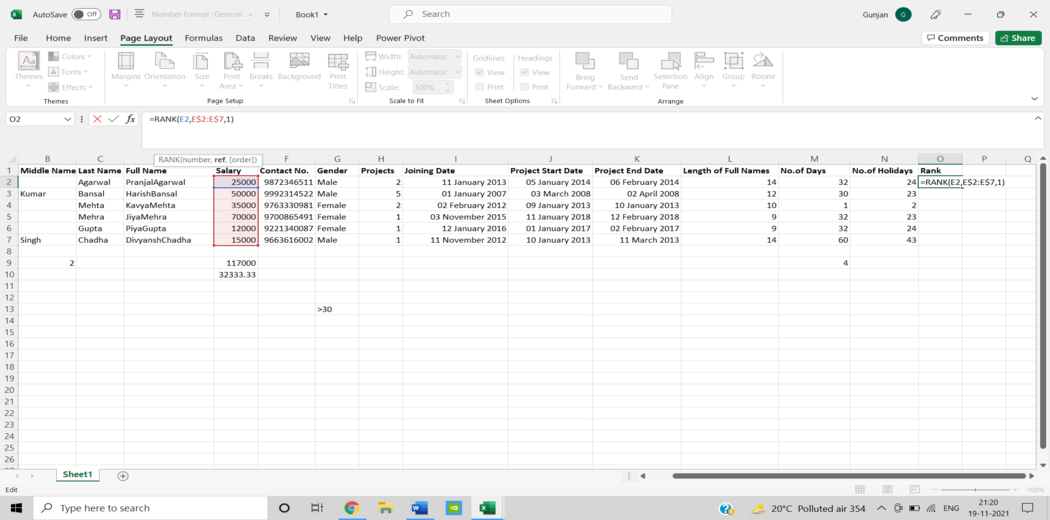
Some of the Methods for Data Analysis in Excel are:
1) Ranges and Tables
The information you have can be in the form of a table or a range. Whether the data is in a range or a table, certain actions can be performed on it. Certain procedures, however, are more successful when data is stored in tables rather than ranges. There are some operations that are only applicable to tables. You will also gain an understanding of how to analyze data in ranges and tables. You’ll learn how to name ranges, how to utilise them, and how to manage them. The same may be said for table names.
2) Data Cleaning – Text Functions, Dates and Times
Before moving on to data analysis, you must clean and organize the data you’ve gathered from multiple sources. The following approaches can be used to clean data in Excel.
• With Text Functions
• Containing Date Values
• Containing Time Values
3) Conditional Formatting
Conditional formatting instructions in Excel allow you to colour cells or fonts, as well as place symbols next to values in cells, based on predetermined criteria. This aids in visualizing the most important values.
It allows you to highlight cells with a different colour depending on the value you set to them. Rules, data bars, colour scales, icon Sets, finding duplicates, shading alternate rows, comparing two lists, conflicting rules, checklists, and creating Heat Maps all benefit from conditional formatting.
4) Sorting and Filtering
You may need to sort and/or filter your data to prepare for data analysis and/or to display specific critical data. You can perform the same thing in Excel using the simple sorting and filtering options. Sort and Filter are the most used Excel functions. Within columns, sorting can be done in ascending or descending order. Lists can be sorted by colour, reversed, or randomly generated. Filters are used to display data that meets requirements. Number and Text Filters, Date Filters, Advanced Filter, Data Form, Remove Duplicates, Outlining Data, and Subtotal are some of the options.
5) Subtotals with Ranges
PivotTables are commonly used to summarize data, as you are aware. However, Subtotals with Ranges is another Excel function that allows you to group/ungroup data and summarize data in ranges in a few simple steps.
6) QuickAnalysis
You can quickly execute numerous data analysis activities and create quick representations of the results with Excel’s Quick Analysis function.
7) Understanding Lookup Functions
Excel Lookup Functions allow you to search through a large amount of data for data values that fit a set of criteria. Vlookup and Hlookup are two different types of lookup engines. Analysts use Vlookup and Hlookup to discover a value in a database and retrieve other values that correspond to that value. Data analysts frequently use it to integrate and consolidate useful data from several excel sheets.
8) PivotTables
PivotTables allow you to summarise data and create dynamic reports by modifying the PivotTable’s contents. You can use pivot tables to extract important data from a vast dataset. This is the most practical method of data analysis. After inserting a Pivot Table, you can drag fields, sort, filter, or change the summary calculation. Two-dimensional Pivot Tables are also possible. Group Pivot Table Items, Multi-level Pivot Table, Frequency Distribution, Pivot Chart, Slicers, Update Pivot Table, Calculated Field/Item, and GetPivotData are all important functions.
9) Data Visualization in Excel
Charts are simple to make and display data in a variety of ways, making them more helpful than a sheet. You can make a chart, modify its type, adjust the row or column, the legend location, and the data labels. Column Chart, Line Chart, Pie Chart, Bar Chart, Area Chart, Scatter Plot are some of the different types of charts provided in Microsoft Excel.
10) Data Validation
Only valid values may need to be entered into cells. Otherwise, they risk producing erroneous results. Using data validation commands, you can rapidly set up data validation values for a cell, an input message prompting the user on what should be typed in the cell, validate the values provided against the supplied criteria, and display an error message in the case of incorrect entries. It may be necessary to insert only valid values into cells. Otherwise, they could result in inaccurate calculations. You may quickly set up data validation values for a cell, an input message prompting the user on what should be typed in the cell, validate the values entered against the given criteria, and display an error message in the case of wrong entries using data validation commands.
11) Financial Analysis
Excel has several financial features. However, you may learn to employ a combination of these functions to solve common situations that need financial analysis.
12) Working with Multiple Worksheets
It’s possible that you’ll need to run multiple identical calculations in different worksheets. Instead of duplicating these calculations in each worksheet, you can complete them in one and have them display in all of the others. You may also use a report worksheet to compile the data from the multiple worksheets.
13) Formula Auditing
When you utilise formulas, you should double-check that they are working correctly. Formula Auditing commands in Excel assist you in tracing previous and dependent variables as well as error checking.
14) What-if Analysis
You can extract critical data from a large dataset using pivot tables. This form of data analysis is the most practical. You can drag fields, sort, filter, and adjust the summary calculation after a Pivot Table has been inserted. Pivot Tables can also be made in two dimensions. The functions of Group Pivot Table Items, Multi-level Pivot Table, Frequency Distribution, Pivot Chart, Slicers, Update Pivot Table, Calculated Field/Item, and GetPivotData are all essential.
Data Analysis with Microsoft Excel
- Step 1 – DATA CLEANING USING TEXT TO COLUMN
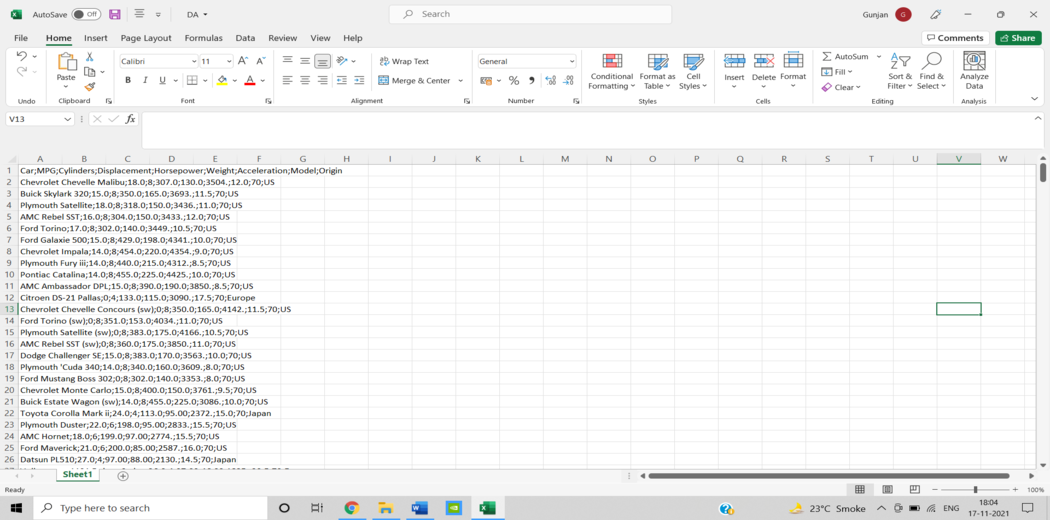
SELECT FIRST COLUMN AND THEN GO TO THE DATA AND SELECT “TEXT TO COLUMN”. SELECT DELIMITED FROM THE APPEARING WINDOW AND PRESS NEXT.

THEN, TO SEPARATE THE DATA, SELECT DELIMITOR/SEPERATOR IN ACCORDANCE WITH THE DATASET REQUIREMENTS. THE REQUIRED DELIMITOR FOR THE GIVEN DATASET WAS ” ; “.
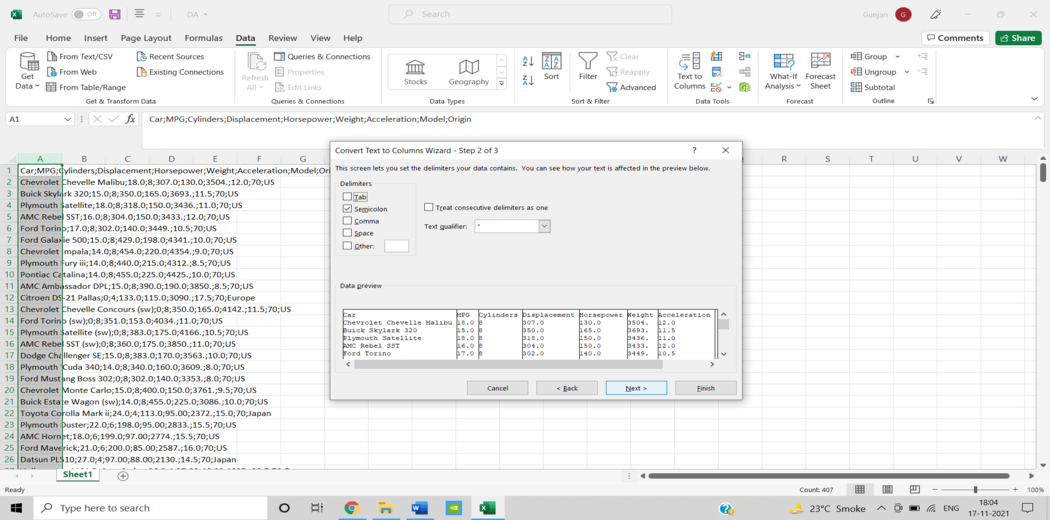
AFTER CLEANING THE DATASET, CHECK FOR THE DATA PREVIEW AND FINISH THE PROCESS.

FINALLY, YOU WILL BE ABLE TO GET THE CLEANED DATA.
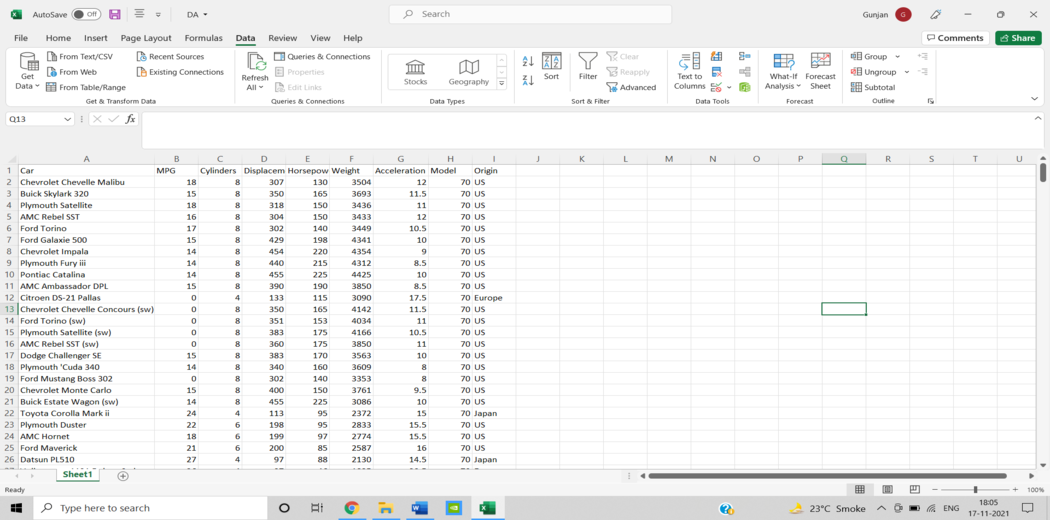
- STEP 2- CONDITIONAL FORMATING
By using Rules, you can specify any number of formatting conditions.
• Highlight cells rules can help you find the rules that are appropriate for you.
• Rules for the top and bottom
You can even make up your own set of rules. You can
• Add a rule
• Remove a rule that already exists.
• Keep track of the defined rules.
SELECT THE COLUMN FOR CONDITIONAL FORMATTING AND THEN SELECT “CONDITIONAL FORMATTING” OPTION FROM THE HOME TAB. MANY RULES WILL BE VISIBLE UNDER CONDITIONAL FORMATTING, SO SELECT THE RULE YOU WANT TO APPLY TO THE COLUMN.
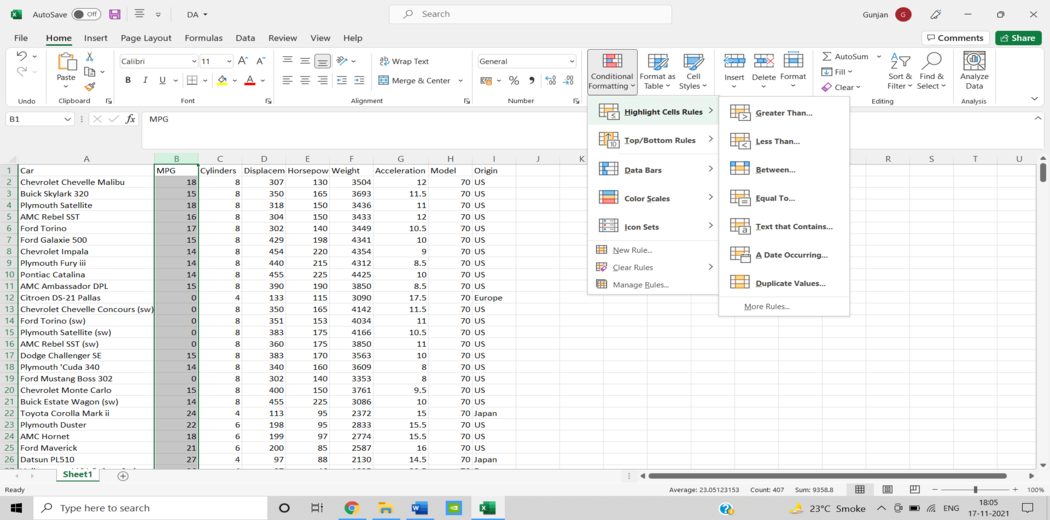
SELECT THE REQUIRED VALUE AND THE COLOR TO BE APPLIED ON THE CELLS, AFTER SATISFYING THE RULE.

Comments
Post a Comment